You have no items in your cart. Want to get some nice things?
Go shopping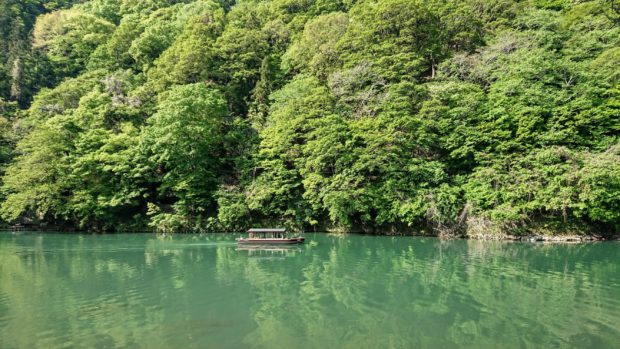
Start from part one of this series.
We had just missed the sakura. During the American prologue of our honeymoon, cherry blossoms had appeared and, for a few days, added another layer of beauty to the Japanese landscape. People had attended festivals in lantern-lit parks, where they drank and ate with friends beneath those graceful pink clouds. Having wolfed down our lunch of ramen in a cosy, family-friendly restaurant where constructing your meal and slurping it down were roundly encouraged, we ambled along the Philosophers’ Walk. Running along a canal, this route is one of the prime spots to admire the fully-bloomed sakura in Kyoto. On the one hand, we were happy to walk freely on a narrow path that not too long beforehand would have been heaving with crowds. On the other, we were sad to have missed the sight. We watched the bare trees pass us by, and took a detour to a temple on a quiet, lush hill.
Thankfully, we had also consoled ourselves with a treat: shaved ice. Flavoured with a choice of syrup and rendered even more waist-bothering with carnation milk, it’s a dessert that we’d been informed by a friend had reached its zenith of deliciousness in Kyoto. (Having later tried some in Tokyo, I can attest to the truth of her statement.)
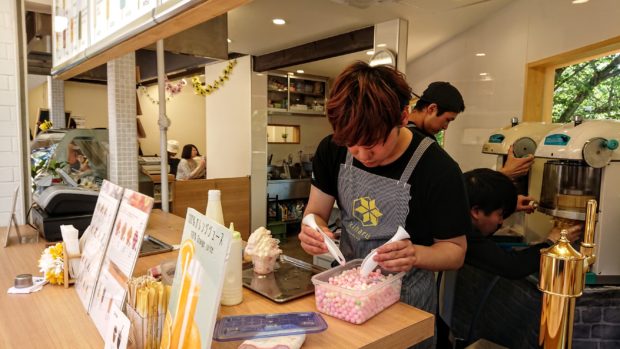
On our way to yet another temple, we found ourselves in leafy suburbia, which it turns out has a universal feel. We heard a familiar sound, one you wouldn’t normally associate with Japan, and followed it to a middle school, where an outdoor concert was taking place. Parents and teachers and friends sat in rows in the sunshine, watching a brass band made up of teenaged boys. We recognised the melody, but couldn’t place it. The language of the school concert, however, was immediately familiar to us; the tense pride of the watching parents, the unsure stance of an adolescent trying to assert himself in a vaguely embarrassing situation. We hung around for a while. The moment stayed with me for longer than whichever temple we’d been heading for.
Just a week earlier, these suburban streets might have been covered in cherry blossom. Soon these children will be adults. Things come and go.
*
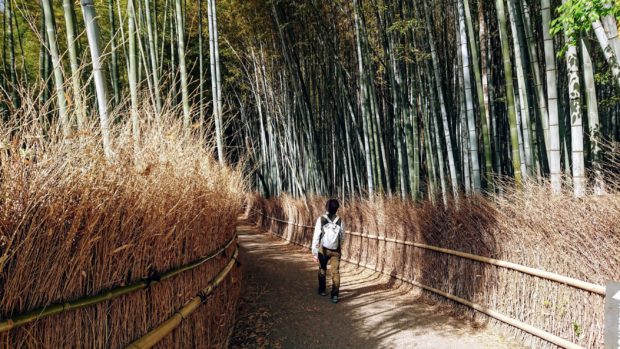
The Japanese have a saying for good honest folk: “a man like fresh-split bamboo”. The country’s warm, humid climate has allowed for the plant to flourish, making it a ubiquitous feature in crafts, construction and folklore (in her tale, the radiant Princess Kaguya is birthed from a stalk). For centuries bamboo has stood as a symbol of strength and purity. Its groves are where people are advised to run in case of an earthquake.
With four weeks in Japan, I figured our risk of experiencing an earthquake was rather high. If one were to occur now, we could at least take comfort in having already travelled to a bamboo grove: the Arashiyama forest, on the outskirts of Kyoto. A path had been cleared through the dense, elegant wood. The sun was creamy on the stalks. To avoid large crowds, we got there early. We’d already been to see the Golden Pavilion (Kinkaku-ji), a zen spot in which we battled thousands of other tourists queuing around the perimeter of its lake, every one of us trying to capture on phones and cameras an air of tranquillity. The happiest moment we’d experienced there was sitting on a stone wall afterwards, eating ice cream lollies made of strawberry-and-matcha chocolate. Here in the grove, there still walked tourists with bionic arms of selfie-sticks, and we all seemed to gather at one particular point to take futile backlit snaps of the sunlight peeking through the meeting tips of the stalks. But if we let the others walk off without us, or walked further ahead ourselves, we felt the comforting isolation of being small and swallowed by nature.
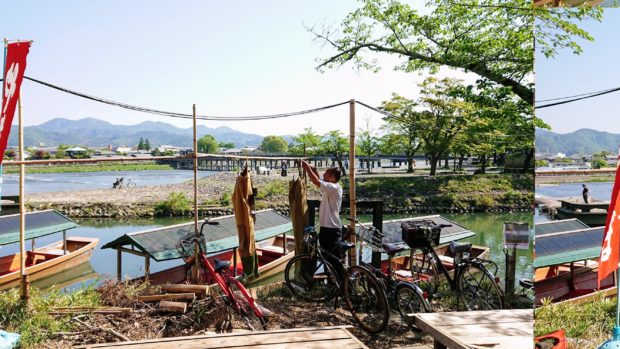
Once we’d cleared the bamboo grove, we ambled further along through the park. We climbed a small hill, and through the trees and bushes on its summit we beheld a sight we had not prepared for at all – one that was, for me, literally breathtaking. The Katsura river was the purest turquoise I’ve ever seen. It moved calmly alongside a wall of lush rising hills, and we sat on the bank to watch it flow. Every so often, someone would arrive with supplies and wait for a boat to travel across from the opposite bank, pick them up, and ferry them back to what appeared to be a restaurant or bar made of wood. I tried to picture those steep green hills covered in sakura, then I let that go. This was beauty enough. Eventually we tore ourselves away, and continued towards the centre of Arashiyama. It’s a cute little district of Kyoto replete with fishing boats and a music box museum. There, we saw another lot of people being ferried. Muscled local men in black shorts lifted rickshaws of two passengers at a time and raced off with them as horses would.
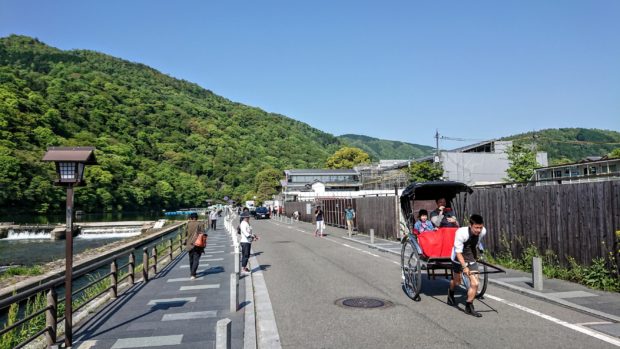
What impressed me most about the spectacle was, in fact, not the sheer strength displayed by these sweating cabbie alternatives (known as shafu or jinrickisha danshi, “rickshaw boys”). It was an observation that landed on me swift and heavy as hands on my shoulders: this is not the image we are ever fed of Asian men. I recalled the kung-fu films of Bruce Lee we used to watch as children, the thrilling inventiveness of Jackie Chan – these were powerful but lithe figures, whose presences had rapidly diminished from popular culture as I’d got older. What had superseded these images were the stereotype of a tiny Asian penis, and the many reports from gay men who’d seen the phrase “no Asians” one too many times on Grindr. Statistics have revealed that Asian men receive the lowest response rate on dating sites and apps. Asians are generally regarded by Westerners to have “delicate” or “fine” features, which translates to “feminine” for many and is therefore easily dismissed as “not manly enough” (according to stereotypes of masculinity, of course) – or the more insidious “not my type”. Conversely, in Japan it seems to be the pretty boy, the bishōnen, who rules the roost. You see his slight form, poetic face and medium-to-long pop-star hair on almost every advert that isn’t illustrated. I couldn’t help but wonder where these poor buff guys lugging rickshaws fit in.
We carried on past a pint-sized Coca Cola van and its accompanying baseball-capped delivery man (the cap is a common feature in Japanese trade uniforms) to Hōrinji. Sitting on top of those lush hills I’d been gawking at from the lakeside, this Shingon Buddhist temple offers a terrific view of West Kyoto. We’d arrived, it transpired, just in time for a ceremony. A pre-pubescent girl, all dolled up in a beautiful gown, was signing a piece of paper at a long table as members of her family took pictures. We gathered it was some sort of coming-of-age ritual, akin to the Catholic confirmation. But we didn’t find out because we didn’t think to ask. We simply watched, as if from a window.
*
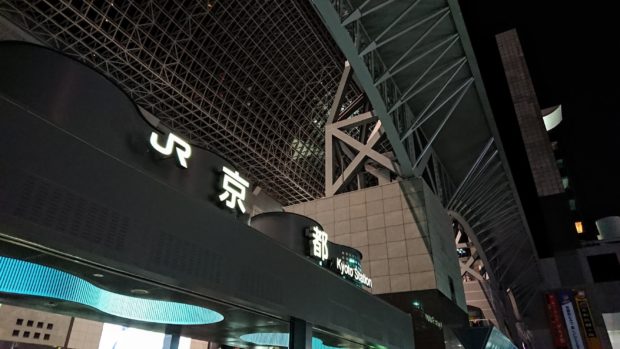
We didn’t want to leave Kyoto. But as we neared the end of our stay, we thought it only appropriate to visit one of the city’s key attractions: its central station. Designed by Hiroshi Hara, its curved roof of steel bars reaches a height of fifteen storeys, making it the second largest station building in Japan after Nagoya. Housing not only overground and underground railway lines, the station is also a centre for shopping, food, drink and entertainment. On top of all that it includes a hotel and local government facilities. It’s a bracing experience. But although you feel awestruck by the sheer scale of it, as if looking up might propel you into space, there’s a pleasing comfort in simply wandering around, taking it all in. We stood still on a long escalator, for once not walking up one, simply watching the patterned LED lights flowing down like rapids at our side. The escalator dropped us off at a sky garden where small groups of friends sat chatting on bamboo planters beneath the moonlight. From there our eyes stretched across the city in a darkness flecked with the oblongs of illuminated windows. We then entered a restaurant from which we could access a walkway. The steel bars arched and crossed over us on our path, allowing glimpses of the landscape through the gaps. We descended another long escalator to a quiet square by the hotel, where a pagoda made of fairy lights sat empty. After our fortunate sighting of a geisha in Gion, it seemed only appropriate that we were bidding farewell to Kyoto in this manner: wandering through this space in a reverential awe, hoping to catch a glimpse of something that remained always seductively out of reach.
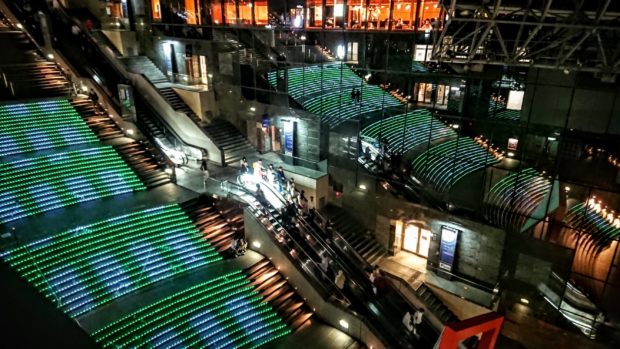
To be continued.
Polis Loizou’s debut novel, Disbanded Kingdom, is out now.

About Polis Loizou
Polis Loizou is a co-founder of The Off-Off-Off-Broadway Company, which primarily performs his plays, and has had a series of successes since their first hit at the Buxton Fringe in 2009. His short stories have been featured in The Stockholm Review of Literature and Liars’ League NYC, and he is a frequent contributor to Litro Magazine. Born and raised in Cyprus, Polis is currently based in Nottingham after 14 years in London. 'Disbanded Kingdom' is his first published novel. He is currently represented by Litro's bespoke literary agency, Litro Represents.
- Web |
- More Posts(25)



